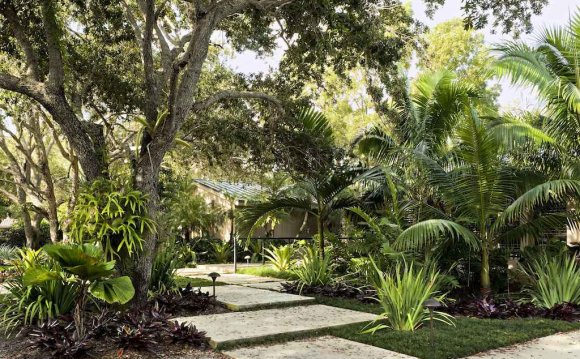
 Less is more, or rather, less, but more of them, is the key to tropical garden design.
Less is more, or rather, less, but more of them, is the key to tropical garden design.
A danger with any form of gardening is falling into the collecting trap . This is no less hazardous with tropical plants. The temptation to buy 'just one more' when visiting your favourite plant shop can be overwhelming. We've all been there. You have to be strong and fight the urge. Otherwise you get home and are faced with the dilemma of "Now what am I going to do with it?" The poor old plant then gets stuffed into an inappropriate place or simply languishes in its original pot.
Conventional gardening in temperate areas, and in particular, Britain, concentrates on having 'interest ' at all times of the year. This means that each month through out the year there will be part of the garden with flowers appearing. Very often these flowers will not be visible unless down on hands and knees with a magnifying glass. If there are no flowers present say during the depths of winter, a brightly coloured stem may be deemed 'winter interest'.
Creating a tropical garden design is more of a stage production. A musical or a classical concert. Everything is working together towards the final crescendo, before the first frost. The plants just get bigger and bigger until one morning you wake up and it is all over. Until next year of course, when everything new you learned this year, can be applied to make the next display even better.
In order for our production to work, we need two types of performers. Hardy plants and tender plants.
Hardy plants in this instance will be classified as any plant that will survive in your garden with little or no protection during the coldest months. I like to term them permanent plants. The range of these plants diminishes the closer to the north pole you live. (Unless of course you are a citizen of the southern hemisphere).
Hardy plants need to be planted in groups of hardy plants. There are a couple of reasons for this:
Hardy plants, once established, will have first dibs on water and food resources. If you then plant your tender tropical plants close by, they will struggle to compete. There is little altruism between plants.
Another thing to consider is the use of herbaceous perennials. These plants are designed for the northern climate. Some of them blend nicely with the theme of tropical plants. Hostas for example blend in with a tropical garden design. However the Hostas know what is on the cards come October time. These plants will begin to wind down in the autumn and become a little scruffy in the process. So it is best not to combine them directly with tropical plants which continue to look good. The tropical plants are oblivious to what winter is and keep growing happily until they have a nasty shock.
If you plant hardy plants amongst your tender plants, initially the hardy plants may become engulfed by the faster growing tender plants. Once the frosts come, you will be left with a few lone plants rising from the earth. This was a mistake I made with echiums. The plants grow quickly in their first year and blend with the tender plants. Once the frost has removed the surrounding plants, they look a bit silly all on their own. Chances are that this plant will also be in the way when planting out next years scheme.
The tender plants will take no frost. In some cases however, the roots will remain alive if protected by a layer of mulch. I like to think of tender plants as transitional plants. You have more creative freedom with these plants. Each year you can create a new design. Because they grow so quickly, you will see the results of your ideas by the end of the season. There is no waiting for years whilst the plants mature. This is particularly useful if your design happened to be rubbish. You just start again next year, incorporating any positives into you new tropical garden design.
A mixed tropical border
I like to think of tropical garden design as creating a view. As with any view there are certain aspects which make the view pleasant or less so. With any natural landscape it is often the simplicity which gives it beauty. As soon as a view becomes too congested it looses some of its beauty. Likewise in a garden, you want to keep it simple.
My wife gave me a coffee table book called the tropical garden. The book contains no gardening information. It is simply a collection of photographs of tropical gardens. I find this book the most inspiring when it comes to planning the garden. The tropics of course do not have seasons as we know them, only different levels of discomfort. This makes the truly tropical garden so much different to English idea of how to do things.
To recreate the impression of the tropics, you need to accept that you can only have a garden for six months. Yes you will still have pockets of exotic greenery during the winter but it wont look desperately happy. Concentrate on the growing season and create a stunning show.
YOU MIGHT ALSO LIKE












